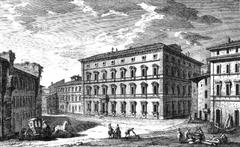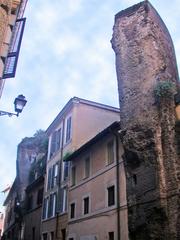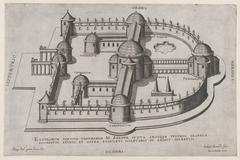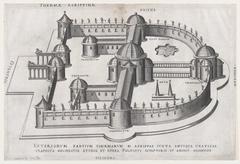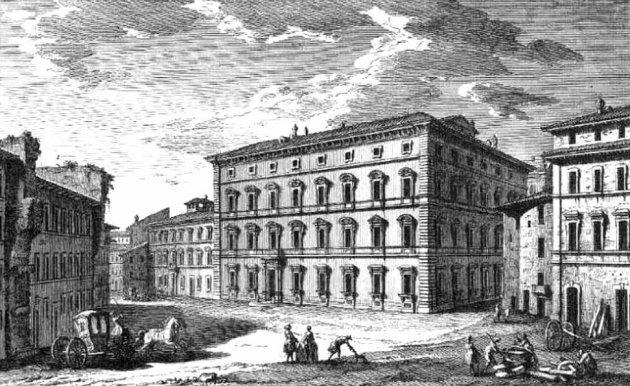
Baths of Agrippa Visiting Hours, Tickets, and Rome Historical Sites Guide
Date: 14/06/2025
Introduction
The Baths of Agrippa (Thermae Agrippae) represent a foundational chapter in Rome’s architectural and social history. Constructed under Marcus Vipsanius Agrippa and completed in 25 BCE, this was Rome’s first monumental public bath complex and a template for future imperial thermae. Located near the Pantheon in the historic Campus Martius, the baths were not only innovative feats of engineering—thanks to their connection with the Aqua Virgo aqueduct—but also vibrant hubs of social, cultural, and political life. Today, although only fragments remain, the Baths of Agrippa offer visitors a rare window into the origins of Roman leisure and public amenities (official Rome tourism; Wikipedia; Livius.org).
This guide covers the site’s historical significance, architectural highlights, practical visiting information, and tips for exploring nearby Roman landmarks.
Table of Contents
- Introduction
- Historical Background and Construction
- Social and Cultural Impact
- Architectural Features and Legacy
- Visiting Hours, Tickets, and Accessibility
- Tips for Visiting and Nearby Attractions
- Frequently Asked Questions (FAQ)
- Conclusion and Visitor Tips
- References
Historical Background and Construction
Commissioned by Marcus Vipsanius Agrippa—Augustus’ confidant and son-in-law—the baths were completed in 25 BCE as Rome’s first monumental bath complex (official Rome tourism). Initially, the facility contained a heated laconian sudatorium and gymnasium, reflecting Greek influences. With the completion of the Aqua Virgo aqueduct in 19 BCE, the baths gained a direct and abundant water supply, marking a breakthrough in Roman hydraulic engineering (Xixerone). This innovation made the baths accessible and attractive to all classes of Roman society.
Upon Agrippa’s death in 12 BCE, he bequeathed the baths to the Roman people, abolishing entry fees and establishing the first truly public bath in the city. This set a new civic standard for subsequent emperors and shaped the future of Roman urban life (wikiwand.com).
Social and Cultural Impact
The Baths of Agrippa quickly became centers of daily Roman life. They were remarkable for their inclusive environment, attracting senators, merchants, freedmen, and slaves. The baths fostered a spirit of social egalitarianism rare in ancient society, providing not just spaces for bathing but also for exercise, education, and cultural activities. Art exhibitions, lectures, and gardens enhanced the baths’ reputation as a hub for both body and mind (wikiwand.com; Roman Gardens).
The connection to the Aqua Virgo aqueduct—still functioning today and feeding the Trevi Fountain—underscored Agrippa’s legacy as a champion of public works. The baths’ integration with this water system was a model for later public amenities and remains a living testament to Rome’s enduring infrastructure (Xixerone).
Architectural Features and Legacy
Layout and Facilities
The original complex measured approximately 90 by 120 meters and featured:
- A monumental domed hall (c. 23 meters in diameter), whose curved brick wall is still visible on Via dell’Arco della Ciambella (Livius.org).
- Standard Roman bath facilities: frigidarium (cold room), tepidarium (warm room), caldarium (hot room), and natatio (swimming pool).
- Expansive gardens and shaded walkways with plane trees, echoing the Athenian gymnasia (Roman Gardens).
- The Basilica of Neptune: a rectangular hall with marine-themed decorations celebrating Agrippa’s naval triumphs.
- A stagnum (artificial lake) and euripus (canal) for aquatic leisure and floating banquets.
Decorative and Artistic Program
The baths were renowned for artistic treasures, including the famous Apoxyomenos by Lysippus and other bronzes, as well as wall paintings with aquatic and botanical motifs (Livius.org; Roman Gardens).
Later Modifications
After suffering damage in the fire of 80 CE, the baths were restored and expanded under Domitian and Hadrian, with further renovations by later emperors. By the 6th century, the site declined after the Aqua Virgo was damaged and was later repurposed as a nunnery (Xixerone).
Today, only fragments remain, including the curved wall on Via dell’Arco della Ciambella and substructures of the Basilica of Neptune.
Visiting Hours, Tickets, and Accessibility
Location
The Baths of Agrippa are situated in the heart of Rome’s historic center, just southeast of the Pantheon, mainly along Via dell’Arco della Ciambella (Livius.org).
Hours and Tickets
- Visiting Hours: The remains are integrated into public streets and open spaces, accessible at any time. There is no formal archaeological park or entry gate.
- Tickets: No ticket or entrance fee is required; the ruins are visible from the street. For more immersive experiences, some guided walking tours of ancient Rome include a stop at the Baths of Agrippa.
Accessibility
- The streets are generally flat and suitable for most visitors, though some areas may be narrow or crowded.
- No dedicated visitor facilities (restrooms, ticket offices) are present at the site.
- The area is accessible by public transport and is within walking distance from major sites such as the Pantheon and Piazza Navona.
Tips for Visiting and Nearby Attractions
- Combine a visit to the Baths of Agrippa with the Pantheon, Piazza Navona, and the Trevi Fountain for a comprehensive historical walking tour (Roman Gardens).
- Early mornings or late afternoons are best to avoid crowds and enjoy softer light for photography.
- The curved wall on Via dell’Arco della Ciambella is a unique spot for photos capturing the intersection of ancient and modern Rome.
- Use reliable travel apps, such as Audiala, for audio tours and additional historical insights.
- As always in busy tourist areas, stay alert to your belongings.
Frequently Asked Questions (FAQ)
Q: Can you visit the Baths of Agrippa today?
A: Yes, you can view the remains, mainly a large curved wall, from public streets near the Pantheon. There is no formal site or admission process.
Q: Are there tickets or set visiting hours?
A: No tickets are required and the area is accessible at all times.
Q: Are guided tours available?
A: Some tours of ancient Rome include the Baths of Agrippa as a point of interest.
Q: Is the site accessible for those with mobility impairments?
A: The surrounding area is generally flat, though streets can be narrow and crowded.
Q: What other Roman baths can I visit with more substantial ruins?
A: The Baths of Caracalla and Baths of Diocletian offer more extensive remains and visitor facilities.
Conclusion and Visitor Tips
The Baths of Agrippa are a cornerstone in the story of Rome’s public health, engineering, and urban life. While only fragments remain, their central location makes them a rewarding stop for those exploring Rome’s historical heart. Combine your visit with nearby sites, use digital resources for context, and take a moment to reflect on the baths’ role in shaping the social fabric of ancient Rome.
For a deeper experience, download the Audiala app for guided audio tours, check official tourism resources for up-to-date information, and explore related articles for a broader understanding of Rome’s bath culture and architectural legacy.
References
- Baths of Agrippa in Rome: History, Visiting Hours, Tickets, and Travel Tips, Turismoroma
- The Myth and Magic of Rome’s Fontana di Trevi: A Deep Dive, Xixerone
- Baths of Agrippa, Wikiwand
- Baths of Agrippa, Livius.org
- Baths of Agrippa, Roman Gardens
- Baths of Agrippa, Wikipedia
- Baths of Agrippa: Visiting Hours, Tickets, History, and Must-See Features in Rome, AJA Online
